Consolidated B-24 Liberator, 42-95278, Corradrishy, Mayo
On the 5 May 1944, the rural quiet of the townland of Corradrishy, Mayo near the town of Foxford was rattled by the crash landing of a massive American Liberator bomber. The crash landing became part of local legend and the story has been in many local and not so local newspapers and publications. This article presents some memories of the American airmen from that aircraft.
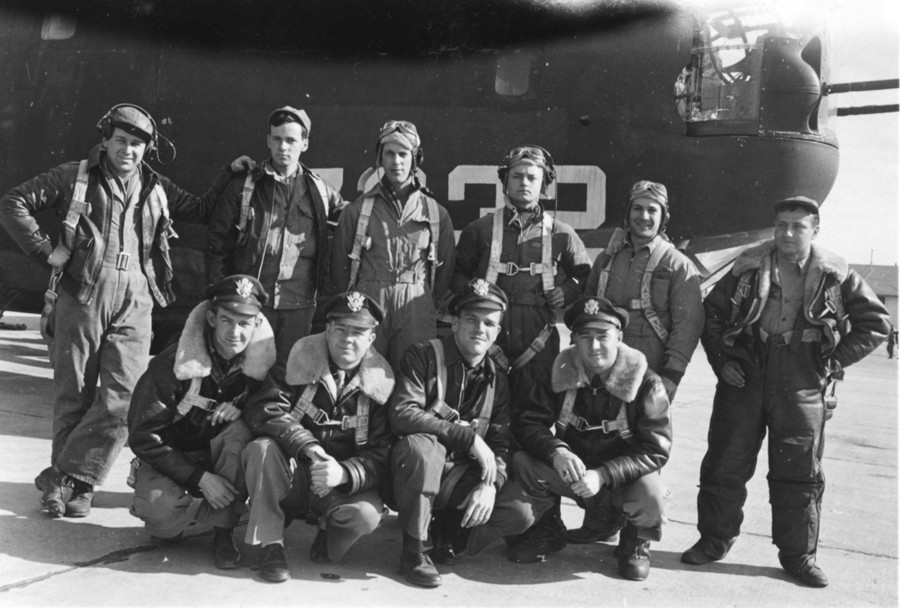 On that day, a crew of young American airmen were
flying a large B-24 heavy bomber from Goose Bay in Newfoundland
to Prestwick in Scotland. At this stage in the war, the United
States Army Air Forces (USAAF), Eighth Air Force based in
England was in its third year of the massive bombing campaign
against Germany. On that day alone, three major missions were
flown against wide range of German targets in France, Belgium
and the Netherlands. Up to 917 four engined USAAF bombers were
despatched on these raids that morning. Bad weather causes many
aircraft to abort their missions but even so, three bombers and
three escorting fighters are lost, five bomber crew members are
killed, 30 crew members are listed as missing in action, four
more bombers return home but are beyond repair while another 170
bombers received lighter damage. Deaths and injuries too the
German forces and local French and Belgium civilians are not
known to this author at this time. It was to top up this
attrition of the US bomber fleet that the subject of this
article took off on its flight across the North Atlantic that
summers day. Due to the size and complexity of the heavy
bombers, it was not practical to ship them across the ocean so
they had to be flown across by the crews that would then fly
them into combat. This was done with poor communications, not
always accurate weather forecasting and using aircraft and
equipment that was often prone to faults and failures. Though
the crews would be spared being shot at, these Ferrying
Operations were still dangerous activities.
On that day, a crew of young American airmen were
flying a large B-24 heavy bomber from Goose Bay in Newfoundland
to Prestwick in Scotland. At this stage in the war, the United
States Army Air Forces (USAAF), Eighth Air Force based in
England was in its third year of the massive bombing campaign
against Germany. On that day alone, three major missions were
flown against wide range of German targets in France, Belgium
and the Netherlands. Up to 917 four engined USAAF bombers were
despatched on these raids that morning. Bad weather causes many
aircraft to abort their missions but even so, three bombers and
three escorting fighters are lost, five bomber crew members are
killed, 30 crew members are listed as missing in action, four
more bombers return home but are beyond repair while another 170
bombers received lighter damage. Deaths and injuries too the
German forces and local French and Belgium civilians are not
known to this author at this time. It was to top up this
attrition of the US bomber fleet that the subject of this
article took off on its flight across the North Atlantic that
summers day. Due to the size and complexity of the heavy
bombers, it was not practical to ship them across the ocean so
they had to be flown across by the crews that would then fly
them into combat. This was done with poor communications, not
always accurate weather forecasting and using aircraft and
equipment that was often prone to faults and failures. Though
the crews would be spared being shot at, these Ferrying
Operations were still dangerous activities.
Flying that day from Newfoundland was a crew commanded by 2/Lt. William A Lummus. He had nine men under his command for the Ferry Flight, the normal crew size for B-24 bomber. 2/Lt Lummus had to file the following report to the USAAF in the aftermath of the crash, the transcript of this is given below, taken from the USAAF Form 14 crash report attachments.
Engines started at Goose Bay at 10:10 GMT. Plane checked OK on Pre-flight and Run Up. Took off at 10:30 Grenich (sic) time. Climbed on course 45” 2550 R.P.M., ceiling was 2000’ broke on top at 9000’, climbed to 11,000’ assigned altitude. Flew at that altitude in between cloud layers for approximately 1 hr. Was cruising at 31 and 2200 to hold alt. and 162 first 2 hrs. Gas checked about 205 and 215 gal per hr at end of second hr. Two hrs after take off plane iced badly. All de-icing eqpt was used. Carb air filters were turned on. After 2 hrs weather was so bad, climbed slowly to 12,300 ft. Weather was better there. Navigator got several star shots and was right on course to coast of Ireland. 800 miles out no contact could be made or weather report received. Engineer reported high gas consumption half was over. Power (RPM) was cut back as much as possible at all time, 100 miles out picked up Beleek range and gas showed I would not safely have enough to make Prestwick. Planned to land at “St. Angelo”. About 45 miles out from Beleek Clouds began to rise up to aprox. 18 to 20 thousand with precip. and turbulence. Electrical disturbance made range and all radio of no avail. Flew and ETA into Beleek and took up reciprocal to let down to minimum alt. of 5000 to try to pick up range on break out. At that time had approx. 30 min gas left. Did not know weather at station so hesitated to go below minimum altitude on instruments. Saw a hole and let down to 1000 ft and picked up range again. Knew I was about 40 miles south east of range so headed for range with fair visibility. Ran into heavy rain and visibility 1 mile. Radio went out again and Engineer reported 15 minutes of gas left. New area near range was mountainous and not suitable for forced landing so I circled over meadows until I found one practical for landing. Landed in a meadow with wheels down and plane was intact until we ran out of meadow and hit peat bog which collapsed gear and set plane down on belly. None of crew was injured. All were prepared for crash landing. IFF emergency was turned on 20 minutes before crash.
As with some of the other crashes of Ferry aircraft which occurred in Ireland, one can see the very real dangers these men faced when dealing with radio equipment that was liable to fail, aircraft engines that were far from reliable, ever changing weather conditions and the rugged European coastline they were flying towards.
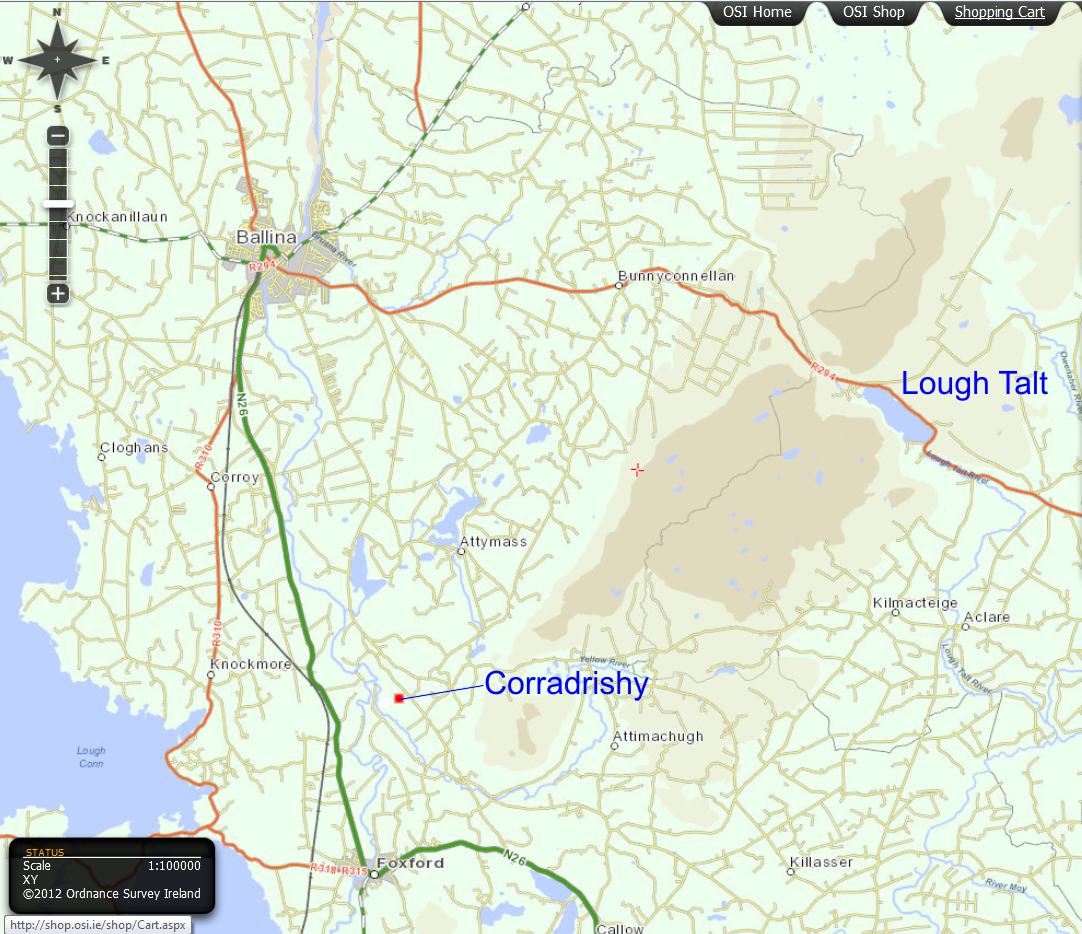
The Irish Army report in the Irish Military Archives records
the landing taking place at around 9:15 in the morning on the
5th of May. The tale is also told in the Foxford historical
publication, Foxford - Through the Arches of Time,
published by James Laffey, October 2003. This is out of print
but there is a copy in the public museum in Foxford and probably
elsewhere in the west of Ireland.
Above all else, though, the war years
in Foxford will forever be remembered for the dramatic
events on a sunny morning in April 1944*. Sylvester Touhy
was on his way to school with a group of friends when the
early morning serenity was shattered by the deafening roar
of an American bomber.
"We saw this bomber coming over Braid with its engines
spluttering. The plane was obviously in trouble and it just
managed to clear the mountain. At first we thought we were
going to be bombed and we jumped into Howley's Field [now
Hanahoe's]. The pilot knew he was going to come down and he
circled the town before banking away towards the Ox
Mountains and came down in Curradrish."
John Tubbs, of Guildford, Connecticut, was the bomber aimer
in the 'plane - a US Air Force Liberator. Many years later
he visited Foxford and recounted the extraordinary story of
his 'plane's crash landing.
“We were flying over from Newfoundland and had been fourteen
hours in the air when we ran into heavy squalls. All our
navigation instruments went out, and we were very low on
fuel. I was in my position in the nose and our pilots asked
me to keep an eye out for any break in the cloud. I remember
seeing green grass, which looked as if we were over
Ireland—our destination, in fact was a Northern Ireland
base. When I spotted a large hole in cloudbank our chief
pilot said: “I'm going down to see if I can get a place to
land.' There were cattle in the fields, showing, we thought,
that the ground was solid and we scared them off by low
flying. Then we touched down on what turned out to be a soft
peat bog which tore off the landing gear. The bomb bay doors
burst open and scooped the peat into the plane. This slowed
down the forward movement and acted as a cushion. I remember
one engine was smoking, and there was a bit of fire, but
rain came and put it out. Miraculously, all ten of us got
out with very minor scratches."
It was a frustrating morning for the boys in the national
school. The biggest drama of their young lives was unfolding
a few miles out the road and they had to sit through the
usual classes. The day could not go quickly enough.
"We were all agog and thought school would never end," says
Sylvester. "Everyone was going out to Curradrish to see this
'plane' It was like a pilgrimage; they were coming from all
over Mayo."
The Pilot and his comrades were brought to Johnny
O'Donnell's (now Cruiser's) where they were served a
traditional Irish breakfast! Fr. Pat Fahy, who lived next
door, was one of the many curious spectatots in O'Donnell's
that morning.
"It was during the war so food was pretty scarce. They were
given a cup of tea, some brown bread and a hardboiled egg.
None of us had ever seen a real Yank up to that and we did
not know how they talked. To us they were talking real funny
and we thought it was great!"
The curious (and there were always a few around town!) were
torn between going to O'Donnells to see 'The Yanks' or
travelling out to Curradrish to see the bomber.
"The crew of the 'plane stayed in O'Donnell's for the day
with the whole town looking in at them as if they were
something out of Mars!" recalls Fr. Pat. "Everyone was
absolutely fascinated by them. I remember my mother asking
them what they ate while there were up in the sky and they
said: 'We eat candy'. Well, we were wondering what the hell
is 'candy'. Later on, we saw that they had black boxes of
sweets, like bulls eyes. They were obviously full of
vitamins. Before they left they gave a box to my mother and
I think we had it eaten in a couple of days. We'd be going
around telling our friends that we were 'eating candy'."
Legally, the crew of the bomber were
'prisoners' of the Irish Free State* as it had adopted a
neutral stance in the war. But, of course, Ireland was only
'selectively' neutral. The 'plane crash in Foxford was
subject to a media blackout and the American pilot and his
crew were surreptitiously smuggled out of the town on the
evening of their dramatic crash. The only evidence of their
unannounced visit was the 'plane itself, languishing in a
bog hole in Curradrish. And it soon disappeared!
NOTE: * The country was officially known by the name Ireland at this time, since the passing of the 1932 constitution. The name of the country in the Irish language was as it is now, Eire. The term 'Irish Free State' of course continued to be used after this time. The airmen would be more correctly described as internees since Ireland was not at war with the belligerent powers. Ireland never interned any USAAF or US Navy personnel who landed on its shore during the war. The vast majority of all American airmen landing in Ireland were on non-operational missions, again in the most part these were trans-atlantic ferry flights, such as B-24 42-95278. The internment policy followed by the Irish government from 1942 onwards meant that 2/Lt Lummus's crew were never in any danger of being interned. No allied airmen were interned after February 1943, and that crew were returning from a bombing raid on France.
 My own father, Joe
Burke, who passed away in January 2012 at the fine age of 93,
was living at the time of the crash and was one of the curious
mentioned above. He cycled from his home at Lough Talt in County
Sligo to the crash site with a neighbour. He often told me about
that visit and that he got to speak with one of the Irish Army
soldiers guarding the aircraft. He always remembered this man
telling him that the tail gunner in those aircraft had only a
few minutes of life left when attacked by fighters. It might not
have been strictly true but it stuck with my father all his
life.
My own father, Joe
Burke, who passed away in January 2012 at the fine age of 93,
was living at the time of the crash and was one of the curious
mentioned above. He cycled from his home at Lough Talt in County
Sligo to the crash site with a neighbour. He often told me about
that visit and that he got to speak with one of the Irish Army
soldiers guarding the aircraft. He always remembered this man
telling him that the tail gunner in those aircraft had only a
few minutes of life left when attacked by fighters. It might not
have been strictly true but it stuck with my father all his
life.
My father is in the photo at left, taken a few years after the
war. He is on the far right of the photo. In the 1990's he
bought me an Airfix model of a B-24. I'm not sure if he
recognized the aircraft type from what he seen in the bog all
those years before.
The aftermath
The Irish Army at the time recorded the names of their charges for a day as Lt W A Lummus, Lt H A MCusker, Lt J H Tubbs, F/O J R Lopp, S/Sgt E E Conway, S/Sgt J S Fraeger, Sgt C D Cheek, Sgt F S Guida, Sgt B S Clegg and Sgt H A Norgaad.
The Irish Army rather blandly reported that the all but the
center section of the aircraft and the bomb-bay section were
handed over the border to Royal Air Force Northern Ireland
(RAFNI) personnel on the 1st of June. The remainder of the
wreckage was blown up. It had required a 21 day salvage
operation by the Air Corps. They had extracted 160 gallons of
fuel from the wreckage during that time. The crew were brought
to the border with Northern Ireland later on in the evening of
the crash being handed over at the Belleek border post at 22:00
hours. Following their arrival back in the custody of their own
military authorities the men were interrogated about their time
in Ireland. This report was obtained from the US national
Archives by Limerick Historian Martin Gleeson. It very briefly
describes the events of that day in Lt. Lummus's own words .
They had flown from Grenier Field in New Hampshire, the Head
Quarters of the USAAF Air Transport Command (ATC) North Atlantic
Division to Goose Bay in Newfoundland. After their forced
landing, they evacuated the bomber and stood back for a few
minutes incase of fire. They were quickly joined by locals and
then members of the Local Defence Forces (LDF) and went into the
town of Foxford with the Irish Army. There they went to
O'Donnells Hotel, the Irish Army describe this as Moy View
Hotel. Lt Lummus traveled back to the aircraft with a Commandant
Murphy of the Irish forces. They finally made contact with COl
Hatheway, the US military attache in Dublin. They were taken too
the border post at Beleek and from there by army truck to
Langford Lodge air field. They flew out of there to England on
the 7th of May.
With the aid of the internet and the able assistance of the US
Air Force Historical Support Office, who provided a copy of the
Form 14 crash report and testimony of 2/Lt Lummus it was
possible to confirm the men's names as:
2/Lt. William A Lummus O-810177
2/Lt Henry A McCusker O-821321
2/Lt John H Tubbs O-704249
F/O James R Lopp O-125252
S/Sgt Elbert E Conway 14184708
S/Sgt Joseph S Frager 17072124
Sgt Carol D Cheek 39694635
Sgt Frank J Guida Jr 32769234
Sgt Robert S Clegg 35602888
Sgt Henry A Norgaard 39115937
The enlisted crew are found on the morning reports of the 16th
Replacement Control Depot on the 16th of May 1944, declared as
awaiting assignment. This arrived quickly with the men
being sent it seems to 2nd Combat Crew Replacement Center (CCRC)
on or after the 25th of May.
Of these ten men, all but one of them would survive the bombing campaign they joined in the following weeks. The men were posted to the 493rd Bombardment Group (Heavy) at Debach, Suffolk, England. They operated the B-24 bomber until the Autumn of 1944. At that time the entire group converted over to the Boeing B-17 Flying Fortress. Following their arrival at the 493rd Bomb Group the Officers and NCO’s at some stage spilt up among other crews. Tragedy would strike the NCO’s on 12th September 1944 when the B-17 that Frager, Norgaard, Cheek and Clegg were crew members on, was shot down over Germany by Luftwaffe fighters on a raid to Magdeburg. Sgt’s Clegg, Frager and Norgaard spent the remainder of their war as prisoners of war; sadly Carol D Cheek was killed. A small biography of each man is presented below with information received from their families and friends as well as from newspapers.
The former airfield at Debach now has an airfield dedicated to its wartime role and to the men of the 493rd Bomb Group, 'Helton's Hellcats'.
Visit the Debach Mueseum Website at this link:
James E Conway, son of Elbert Conway provided these wonderful
images. The photo below contains the crew of Consolidated B-24
Liberator 42-95278 when it landed in Carradreshy, Mayo. These
photos would have been taken in America during the latter stages
of their training after they were placed together as a combat
crew.
Survivor and veteran of the mayo crash landing, Robert S Clegg,
was able to give us the identity of all the men in the photos,
on top of the identities that the Norgaard, Conway and McCusker
families had given us.

Above: back row: Elbert Conway, Robert Clegg, Henry Norgaard,
Carol Cheek, Frank Guida, and Joseph Frager.
front row: James Lopp, John Tubbs, William Lummus, and Henry
McCusker.
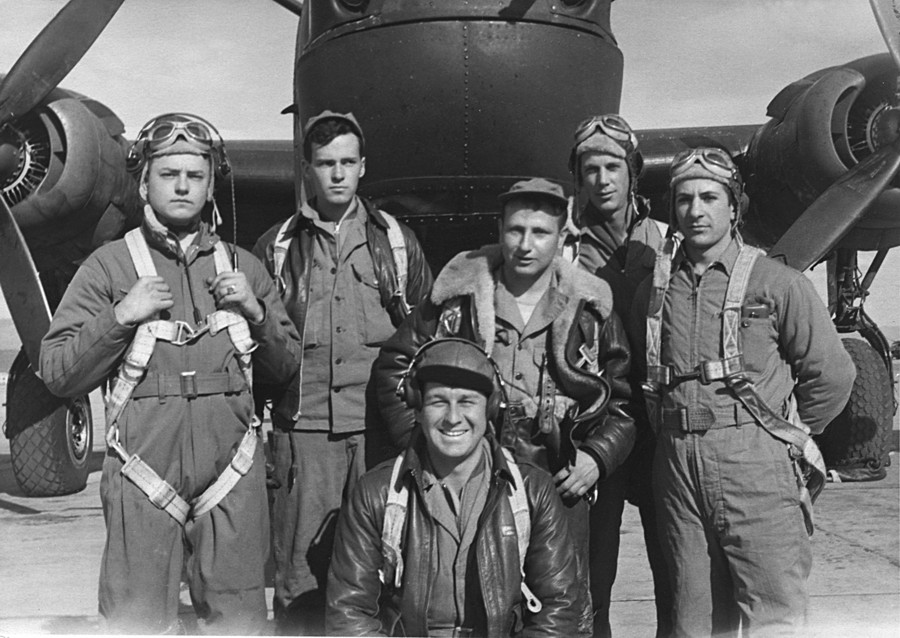
Above: Rear: Carol D. Cheek, Robert S. Clegg, Joseph S. Frager,
Henry A. Norgaard, and Frank J. Guida Jr.
Front: Elbert E. Conway
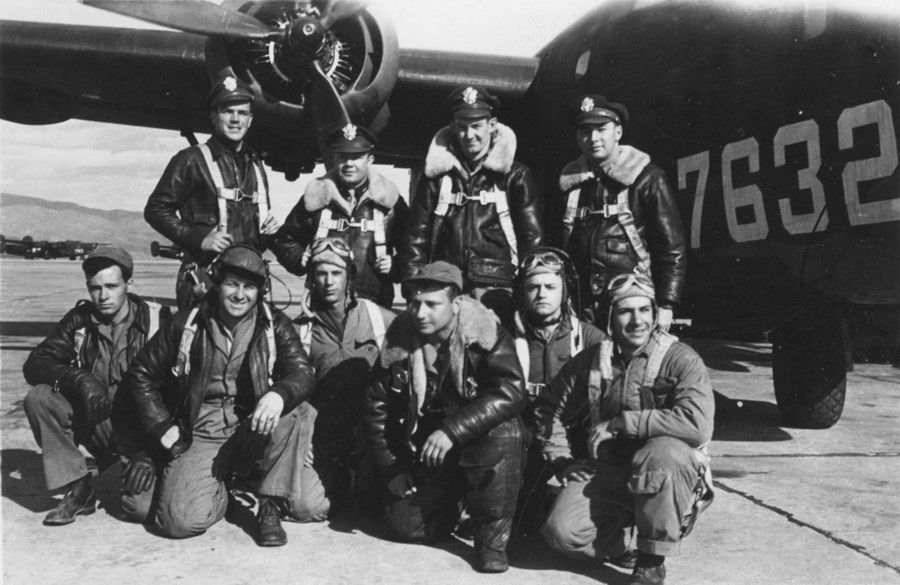
Back row: William Lummus (pilot), John Tubbs (bombadier),James
Lopp (navigator), and Henry McCusker (co-pilot).
Front row: Robert Clegg (waist gunner), Elbert Conway
(engineer), Henry Norgaard (tail gunner), Joseph Frager (radio
operator), Carol Cheek ( ball turret gunner), and Frank Guida
(nose gunner).
The Corradrishy landing, known in some quarters as "The Bomber in the Bog" has been written about in many publications. One such publication was the Connaught Telegraph of 13 April 2010, which is linked here: Connaught Telegraph - BOMBER IN THE BOG. There was also an article in the 7 December 2011 Western People Western People - When rings, bracelets and hen houses fell from the skies . Local man Vivian Sheridan has been very active in recent years trying to record more details of the crash and aftermath from the local area. Time has sadly taken so many of the older generation much has been lost.
The Crew Men
2/Lt. William A Lummus O-810177 (Pilot)
William A Lummus was born in Georgia in June 1920. He entered
the service two years prior to his forced landing in Ireland.
His name as found on a shipping list on August 11th, 1945,
arriving back in New York with other members of the 493rd Bomb
Group on the Queen Elizabeth. He died in 1979 his native
Georgia.
2/Lt Henry A McCusker O-821321 (Pilot)
Henry was born in 1922 and came from New Jersey. Both his
parents, Mary and James McCusker had been born in County Down,
Ireland before later emigrating to America where they met and
married. Henry's daughter Betsy was contacted in 2006,
shortly after his death and she was able to tell that while
Henry never told his family much about his wartime activities,
he did in fact publish a short story based on them. She wrote:
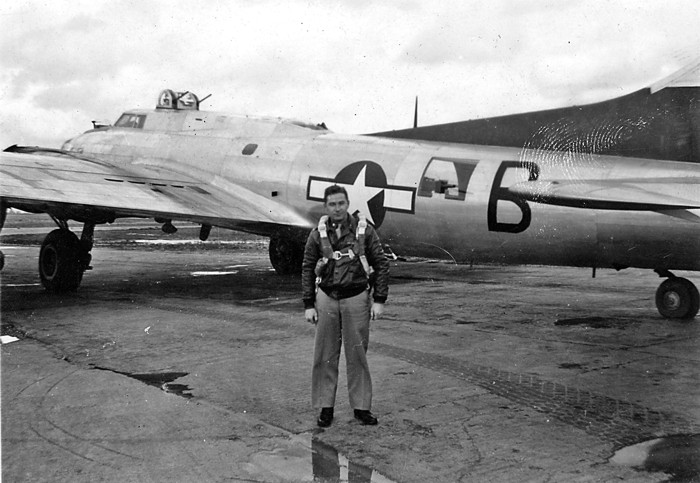 “Inspiration....Sanctified by Fire (was not
published by my dad, but) was published by William J.
Robinson, who also authored the other short story in the
book. My dad's short story is entitled Three Weeks Off
Course.
“Inspiration....Sanctified by Fire (was not
published by my dad, but) was published by William J.
Robinson, who also authored the other short story in the
book. My dad's short story is entitled Three Weeks Off
Course.
George Agar is a fictional character, but the character's
form and substance is that of my dad. The message is from my
dad, through George Agar. Of course, as you know, the flight
did crash and the crew was 'smuggled' out of neutral
Ireland. One of the few people who my dad told about the
incident teased him by saying, "Harry McCusker, the only
prisoner of war of the Irish!" I don't know if all of the
events in the story happened, but my guess is that they did.
After the book was published, my dad contacted O'Connor's
Hotel and enjoyed pleasing correspondence. I'm quite sure
that he mailed a copy of the book to O'Connor's Hotel.”
Betsy was able to learn that her cousin Kevin had been told some
of Henry's wartime stories and he knew of the crash in Ireland,
he reported in emails: “Did you ever
hear, that the only physical injury he received during the
war, even after all those missions, was a sprained ankle
getting out of that plane he crash landed over there in
Ireland on that ferry flight? I, being an airplane nut, used
to ask uncle Harry about the war whenever I saw him, growing
up, which was rarely. I lived in New Jersey, and he and his
family were from Georgia (USA). He didn’t talk much about
it.”
Henry, or Harry as he was known to friends and family, passed
away in April 2006 in Norcross, Georgia.
James Conway found the following photos among his fathers
records, on the back was written: "My co-pilot – the best
officer in the army, Lt. H.A. McCusker from N.J."
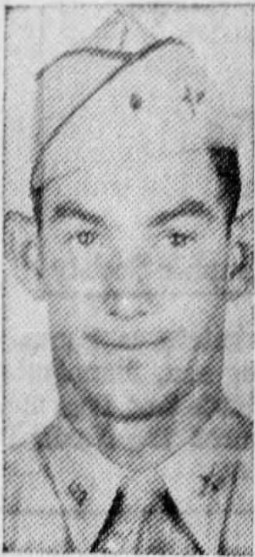 F/O James
R Lopp O-125252 (Navigator)
F/O James
R Lopp O-125252 (Navigator)
James R Lopp hailed from Harrison County, Indiana. He was born
in December 1920
His son, Allen, hoped to transcribed a type written narrative
that his father and mother typed up about his wartime activities
and this does mention the landing in Ireland. Sadly Allen Lopp
passed away in 2013 before further contact could be made.
James' local newspaper ran the following obituary:
James Russell Lopp, 84, Lanesville,
died Tuesday, June 7, 2005, at Floyd Memorial Hospital and
Health Services in New Albany. A native of New Albany, born
Dec. 25, 1920, he was the son of the late Lowell and
Henrietta Beanblossom Lopp. He was an aviator, farmer and a
retired employee of the old Naval Ordnance in Louisville,
where he worked as an industrial engineer. He was an Army
Air Corps veteran of World War II and a member of Shepherd
of the Hills Lutheran Church near Georgetown. He was
preceded in death by a son, Kenneth Paul Lopp, and a
brother, Loran Lopp. Survivors include his wife, the former
Evelyn Dietrich; two sons, Russell James Lopp of Wichita,
Kan., and Allen J. Lopp of Lanesville; a daughter, Sylvia
Lopp Eisert of Seattle, Wash.; a brother, Kermit Lopp of
Anaheim, Calif.; a granddaughter, and four
great-grandchildren.
Jame's remains are buried in St. John's Cemetery, Lanesville,
Indiana.
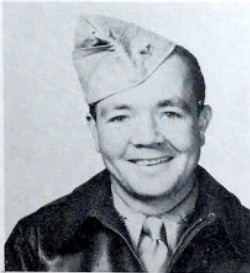 2/Lt John
H Tubbs O-704249 (Bombardier)
2/Lt John
H Tubbs O-704249 (Bombardier)
John Tubbs, born in 1916, came from the New London area of
Connecticut. He was born in Kansas to Stella and Palmer F
Tubbs. His war and subsequent post war career was
regularly reported on by his local newspaper, The Day from New
London, Connecticut.
At the start of the war, he was employed as a weights clerk
with navy inspectors office at the Electric Boat company.
He entered the service in January 1943 and passed through
training with class 43-18 at Midland, Texas, (Oct 1943-Dec
1943), Salt Lake City (Jan 1944 - Feb 1944), Utah and Boise,
Idaho. The paper reported on May 17th, 1944 that he had
arrived safely in England. This was followed on the 1st of
June with news that he had: "...recently
participated in a course designed to bridge the gap between
training in this country and soldering in an active theater
of war."
Following his service in the Second World War, he remained a member of the Air Force Reserve, and was stationed overseas in Okinawa during 1949-1950 as legal officer with the 20th Air Force. He was then assigned to the 65th Bomb Squadron in Arizona.
John H Tubbs actually visited Foxford during the 1990's to see
where his crash had occurred and to meet with local people. He
is quoted in the history publication, 'Foxford, Under the Arches
of Time' and that presented above at the beginning of this
article.
John passed away in February 2002 in New Haven,
Connecticut. He had never married. He is buried in
Old Stone Church Cemetery, Niantic. His headstone records his
service in two wars.
S/Sgt Elbert E Conway 14184708 (Flight Engineer)
Elbert Conway was born in July 1922. Elbert enlisted in the Air
Corps in November 1942, at Craig Field, Alabama. He had told his
family stories of the landing in Ireland. His son James recorded
that: “I do remember him mentioning
the crash. He told me that wherever they took them, he was
across the hall from a Luftwaffe pilot. Whether that was
true or not I have no idea. He knew how much I enjoyed
reading about those things. Would they have even put them
that close together? He gave me a white armband with the
German insignia on it, but I have no idea where he got it.
I'm sure he traded someone for it. He did give me some Irish
coins that he picked up there though. I still have them.”
James remembers a visit in the 1960's that Hank Norgaard made to
his father. They spoke for hours on that occasion.
Elbert ceased flying activities and as James understands it,
transferred to the ground services before returning to the USA.
He passed away in January 1988 in Birmingham, Alabama.
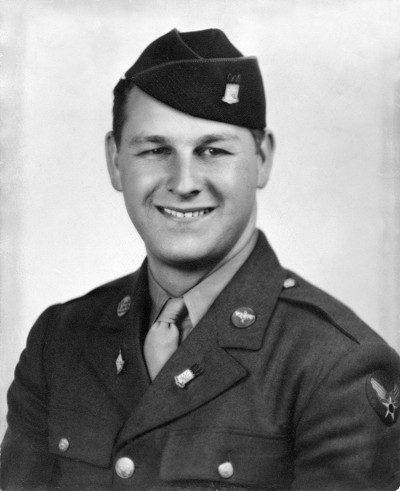 |
|
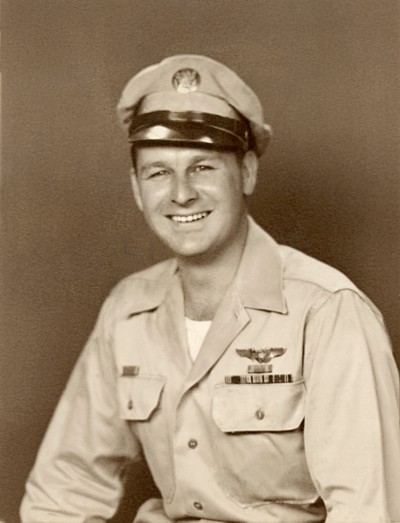 |
Above, Photos of Elbert supplied by his son, James.
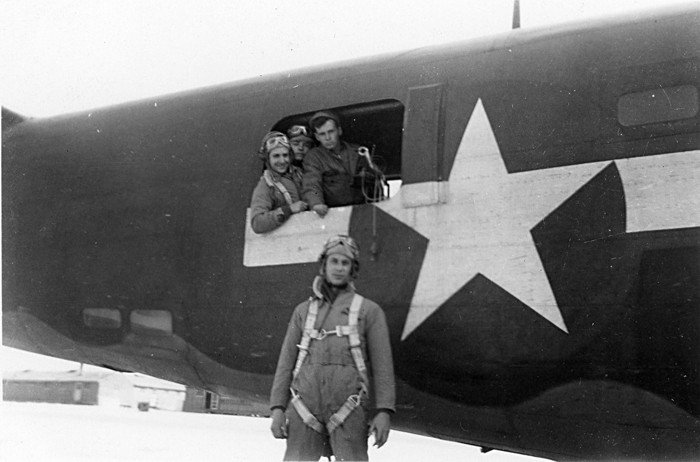
Above: James Conway also found this photo showing airmen Norgaard, Guida, Clegg and probably Carol Cheek inside the aircraft, peeping out.
S/Sgt Joseph S Frager 17072124 (Radio Operator)
Joseph S Frager, born in 1915 in Missouri to Anna and Samuel
Frager. They lived in the city of St Louis. He had one brother,
Sydney Frager. Joseph enlisted in July 1942 in St Louis, his
occupation being listed as a skilled textile worker.
He was shot down with B-17 43-38214 on September 12th 1944 and
held prisoner until the end of the war. His name appears on a
shipping manifest in June 1945 sailing from Southampton to New
York with other liberated prisoners of war. St Louis
newspapers reported that he had to spend until December 1945 at
the Army Air Forces Regional and Convalescent Hospital at Miami
beach, Florida.
The American Jewish Historical Society included Joseph among their post war records. Joseph passed away in Florida in January 1994. His remains are buried in Jefferson Barracks National Cemetery in Missouri.
Sgt Carol D Cheek 39694635 (Ball Turret gunner)
Carol D Cheek was the only member of the crew to be killed
during the war. He was killed in action on 12th September 1944
when the aircraft he was on was shot down, along side Sgt.s
Clegg, Frager and Norgaard . At the time of the crash in
Ireland, Clegg held the unenviable position of Ball Turret
gunner.
He was born in 1924, in Missouri, to Coy and Mary Cheek. At the
time of his enlistment in February 1943 he was resident in
California. The Rosters of US War Dead indicate that his remains
were returned to Missouri for burial. Carol is buried in
Stockton cemetery, Cedar County, Missouri, alongside his
parents. His mother passed away in 1946 while his brother
Darrell is buried with a date of death in August 1948.
Carol's sister Margaret Haynes wrote upon seeing a newspaper
article from Stockton, Missouri. She was able to send on these
wonderful photos of Carol taken during his time with the Air
Force.
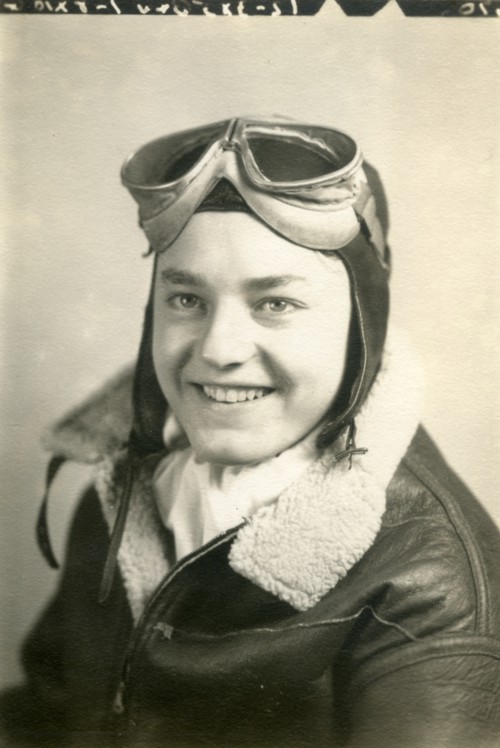 |
|
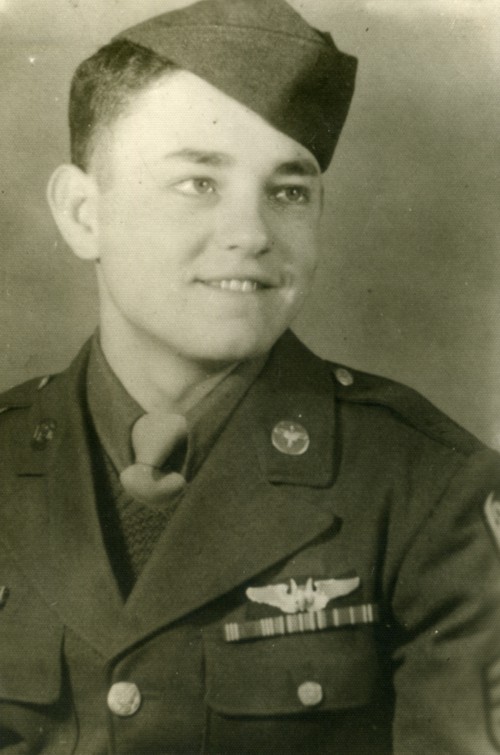 |
Mrs Ramona York of Stockton, Missouri wrote in response to a
letter published in the Cedar County Republican newspaper. She
went to school with the Cheek brothers and their sister
Margaret. She recalled that the family moved to California for
fruit picking. Her cousin Edna would place flowers on the graves
of the Cheek brothers up until her death in 2010.
Margaret was also able to provide a photo of Carol's earlier
grave in Margraten, Holland in 1947. Some of the very kind
people of his home town sent on photos of the Carol’s current
grave stone in Stockton.
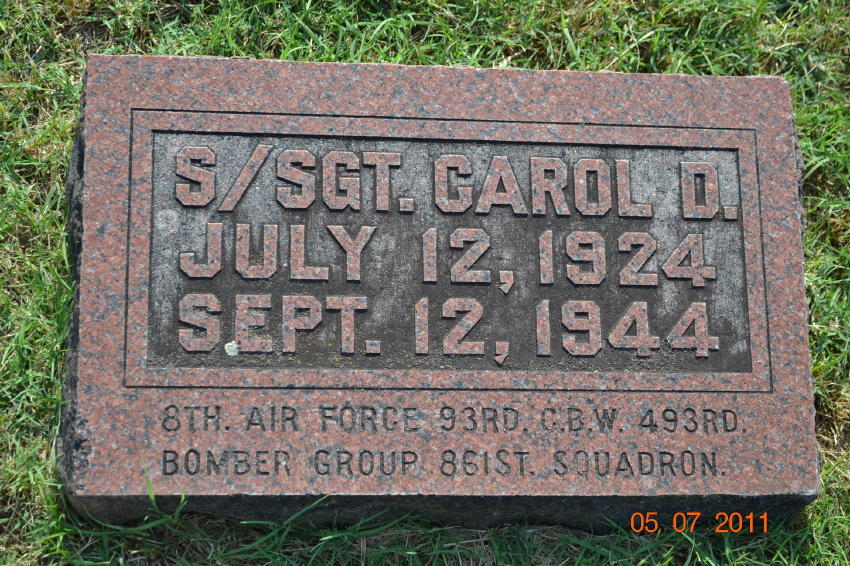
Sgt Frank J Guida Jr 32769234 (Nose gunner)
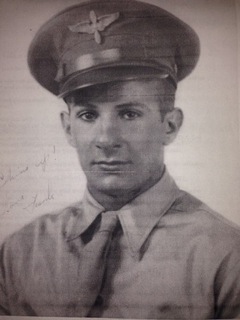 Son of Frank and Stella Guida of Summit, New
Jersey. Frank Guida’s Army serial number is among a batch
of names which are known to be missing. The 32xxxxxx series of
numbers correspond to the Army’s 2nd Corps area which included
the states of New York, New Jersey and Delaware. The escape and
evasion report places Guida as the nose gunner. When contacted,
Robert S Clegg was able to find an old address for Frank in
Summit, New Jersey. This led us to Frank's obituary in the
Orlando Sentinal in 1995:
Son of Frank and Stella Guida of Summit, New
Jersey. Frank Guida’s Army serial number is among a batch
of names which are known to be missing. The 32xxxxxx series of
numbers correspond to the Army’s 2nd Corps area which included
the states of New York, New Jersey and Delaware. The escape and
evasion report places Guida as the nose gunner. When contacted,
Robert S Clegg was able to find an old address for Frank in
Summit, New Jersey. This led us to Frank's obituary in the
Orlando Sentinal in 1995:
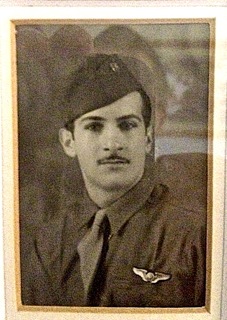 FRANK J. GUIDA, 71, Golf Club Drive,
Longwood, died Tuesday, Jan. 3. Mr. Guida was a diamond
setter. Born in Summit, N.J. on January 22, 1923. After
returning from the war he married Anna Bernice Grady (an
Irish-American girl) of Rutherford, New Jersey and they
settled down in Berkeley Heights, New Jersey, having three
sons, Paul Patrick, Frank James, and James Patrick. He moved
to St. Petersburg, Florida from Berkeley Heights, New Jersey
in 1973, and ultimately to Central Florida in 1985. He was a
member of St. Francis of Assisi Catholic Church, DAV and
Rosicrucians. He was an Air Force veteran. Survivors: wife,
Bernice L. Grady; sons, Paul Patrick, Berkeley Heights,
N.J., Frank James, Altamonte Springs, James Patrick, Lutz;
sisters, Fanny Carfaro, Mary Dykes, Nancy Lombardi, all of
Summit, Ann Vaughn, Fredricksburg, Va., Julie Wighard,
Hollywood, Fla.; brothers, Dominic, Union, N.J., Alfred,
England; five grandchildren. Baldwin-Fairchild Funeral Home,
Forest City "
FRANK J. GUIDA, 71, Golf Club Drive,
Longwood, died Tuesday, Jan. 3. Mr. Guida was a diamond
setter. Born in Summit, N.J. on January 22, 1923. After
returning from the war he married Anna Bernice Grady (an
Irish-American girl) of Rutherford, New Jersey and they
settled down in Berkeley Heights, New Jersey, having three
sons, Paul Patrick, Frank James, and James Patrick. He moved
to St. Petersburg, Florida from Berkeley Heights, New Jersey
in 1973, and ultimately to Central Florida in 1985. He was a
member of St. Francis of Assisi Catholic Church, DAV and
Rosicrucians. He was an Air Force veteran. Survivors: wife,
Bernice L. Grady; sons, Paul Patrick, Berkeley Heights,
N.J., Frank James, Altamonte Springs, James Patrick, Lutz;
sisters, Fanny Carfaro, Mary Dykes, Nancy Lombardi, all of
Summit, Ann Vaughn, Fredricksburg, Va., Julie Wighard,
Hollywood, Fla.; brothers, Dominic, Union, N.J., Alfred,
England; five grandchildren. Baldwin-Fairchild Funeral Home,
Forest City "
Frank's son Paul confirmed in 2011 that his father was a crew
member on the aircraft and he had left some short notes about
his wartime career just before his death. Like many airmen, he
spoke little about his time overseas during the war. His son Jim
reports that he did indeed speak to him of the crash and that
his father was a Technical Sergeant.
Sgt Robert S Clegg 35602888 (Gunner, Waist position)
Robert Clegg was born in 1924 in Ohio. His parents were Stephen
and Betha.
He enlisted in the Army in Belmont Ohio in February 1943. At the
time of the crash in Mayo he was one of two waist gunners on the
B-24 bomber.
He too was one of the men shot down on 12th September 1944,
becoming a POW for the remainder of the war. He is honored by
his local Veterans of Foreign Wars (VFW) post 8796 on the
National WWII memorial website.
Robert featured in a 2009 newspaper article from his native Ohio
Chronicle-Telegraph newspaper. He was among a group of former
POW’s honoured for their wartime service. Reporter Cindy Leise
recorded the following about Robert:
“Fellow POWs Robert S. Clegg, 84, of
Avon Lake, and Tom W. Wilkins, 87, of Elyria, also attended
the ceremony and received a book, a POW/MIA flag and an
American flag. A fourth POW, Arthur M. Rush, was unable to
attend.
Clegg was a waist gunner in a B-17 Flying Fortress that got
shot down in September 1944. After jumping from the plane,
his parachute was pulled away from his body, and he barely
was able to open it and drop to the ground before he was
captured by Germans.
During his fall, Clegg suffered shrapnel wounds in his back
and foot and a knee was injured. He and other prisoners were
tended by an Air Corps captain who had been a doctor before
the war. That fellow POW was Jewish but was treated with a
degree of respect by his German captors because he was a
medical doctor and an American, Clegg said.
Before his prisoner of war camp was liberated the next
spring, Clegg celebrated his 19th birthday. Along the way,
he dropped from 136 to 80 pounds.”
Robert wrote by email via his son-in-law Dan Smith in August
2011. Among other things, Robert was able to identify the names
of the crew men in the photos supplied by Pete Norgaard. Dan
reported that: “He has told the story
many times to us, about how lucky they all were to survive
the crash landing and walk away. He fondly remembers the
reception they received from all the local citizens.”

Sgt Henry A Norgaard 39115937 (Tail Gunner)
Born in 1917 in Iowa to Peter and Anna Norgaard, Henry had moved
to California by the time he came to enlisting the Army. He did
so in San Franciso in December 1942.
He was the tail gunner on the aircraft at the time of the
landing in Ireland according to the crew evasion report.
The Council Bluffs Nonpareil newspaper published the following
article about Henry on 28 August 1944.
Henry was shot down on 12 September 1944 while flying on B-17
43-38214 over Germany.
Council Bluff s (Iowa) Nonpareil newspaper published the
following on November 9th, 1944:
Norgaard listed as Prisoner
T. Sgt Henry A. Norgaard, wearer of the air medal and
personally accredited with having knocked down a German
Messerschmitt 109, is a prisoner of war of the German
government, his mother was notified this week.
Son of Mrs. Anna Norgaard, the Warner apartment house,
he was serving as a tail gunner on a B-17 Flying Fortress
during a raid Sept. 12 over synthetic oil plants in Germany
when shot down, T. Sgt Norgaard also was second engineer on
his ship.
He was graduated from Abraham Lincolm high school in
1935 and prior to entering the army air force, was employed
by the Woolworth company here.
Henry A Norgaard married Patricia Anderson at Santa Rosa
California on March 28th 1946. His brother Sam was his best man.
At that time he was employed at an oil refinery in Rodeo,
California. The marriage was reported in the Council Bluffs
Nonpareil newspaper from his native Iowa.
He was known as ‘Hank’ to those close to him. He passed away in
Pinole, California on 19 Aug 2005. His wife Patricia followed
him in August 2007. Her obituary said of them: “Pat and Hank operated a neighborhood grocery
store in Rodeo for many years. They formed many lifelong
friendships through their business.”
Compiled by Dennis Burke, 2014, Dublin and Sligo. With thanks to Robert Clegg and family, Carol Cheek's sister and the kind people of Stockton, Iowa as well as all the extended families of those on the Foxford Liberator. Also to Vivian Sheridan of Foxford.
